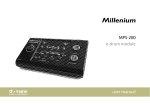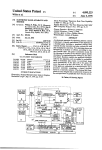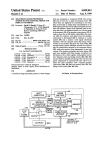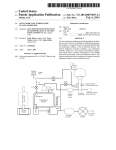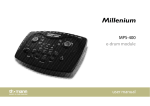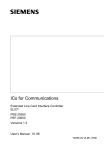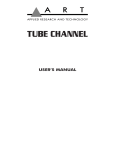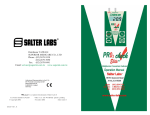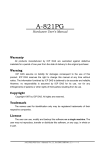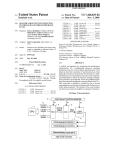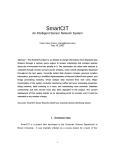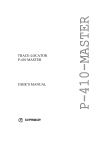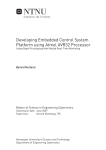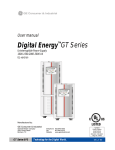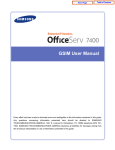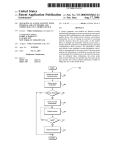Download Dual-processor line concentrator switching system
Transcript
United States Patent ‘[19] Hutcheson et al. [54] DUAL-PROCESSOR LINE CONCENTRATOR Attorney, Agent, or Firm—Phillips, Moore, Weissenberger, Lempio & Majestic [57] [73] Assignee: Glaser, Bonham, Tex.; Richard D. Ross, Reno, Nev.; Wook R. Shim, Rohnert Park, Calif. is included at both ends of the concentrator system. These processors communicate with each other over a Lynch Communication Systems, Inc., randomly chosen idle trunk, thereby negating the need Reno, Nev. for a dedicated communication link between the proces sors. Each processor controls the switching functions at [21] Appl. No.: 850,592 [22] Filed: its end of the concentrator, independently monitors and retains trunk status, subscriber line status and system Nov. 11, 1977 operational status, and provides system fault detection, Int. CI.2 ............................................. ,. H04Q 3/60 U.S. Cl. .............................................. .. 179/18 FC Field of Search .................................. .. 179/18 FC [56] diagnosis and recovery including communication to maintenance personnel of trouble codes based on the detected fault and its diagnosis. Manual interaction with References Cited the system is also enabled at either end of the concentra tor system via display and input/output units or remote from both ends. U.S. PATENT DOCUMENTS 3,592,970 ABSTRACT A switching system is disclosed for the concentration of a plurality of telephone lines onto a lesser plurality of intermediate trunks, wherein an independent processor both of Reno, all of Nev.; James H. 7/l97l Capetti et al. 179/18 FC Primary Examiner--William C. Cooper c.o. 27 Claims, 14 Drawing Figures L "E CONCENTRATOR 8 Jk CENTRAL ?cE TERMINAL I — 'FEMOTE TERMINAL _' _ 7d FI I0 Lilli ..\ U21: " tm c.o. I LINE I I /-~- TRUNK ---2 sure: I "II-Em no: I 2 STAGE 0 LINE I 'I I . FACE l I i I ' i I | I I Il I l II I I "'g MATRIX $W~ i INTER- I || I FACE I l I E I I g i I | 5 I‘ I“ a I II I iI I II I I | I | I I I I I I ' | l ‘ I 1 I ‘ I I‘I | l I I L00 I I Is I ___ ' I I 40 PULSER a con-gem. I as I ‘4 | ITRANSMITTER a REcEIvEa I I 24 I so II I I 3:35;“ J L ‘° PROCESSOR common coIgaoI. | | ' DATA-LINK TRANSMITTE I a REcEIvER PROCES commonson sw. 25cm: i Ttnli amt-LINK I4 I I Is sus SCRIBERS 5“ u I I ' l 5‘? In INTER_ I I I 8“ REMOTE ..__ rnuux Tm I | I _ I I FACE I l 20 Tm I I INTER’ I MATRIX 5W- 2 Apr. 8, 1980 SWITCHING SYSTEM [75] Inventors: Alan G. Hutcheson, Sparks; William R. Bonham; Calvin H. DeCoursey, [51] [52] [58] 4,197,427 [I ll [45] II I I 23 st" i PULSER a L sw. DECODE 52 I I _I 4 US. Patent Apr. 8, 1980 Sheet4 of 12 4,197,427 RAM MEMORY MAP TRUNK STATUS LINE STATUS MISC. OTHER SYSTEM STATUS BITS HANG UP QUEUE r DISCONNECT QUEUE 2048 wonos 0'’ 8 BITS EACH SERVICE REQUEST QUEUE SWITCHING MATRIX STATUS _4 SCRATCH PAD AND POINTER STORAGE Y TYPICAL DATA WORD "BYTE" FIG ._ 12A 5-IO IIIS LEADER F-’% BYTE I BYTE 2 BYTE 3 L J Y SERIAL DATA LINK MESSAGE FIG -125 US. Patent Apr. 8, 1980 Sheet 5 of 12 U [SYSTEM INITIALIZATION OR RECOVERY] PERFORM PTASK SCAN LINE DETECTORS FOR SUBSCRIBER SERVICE REQUEST AND QUEUE DETECTED REQUESTS I PERFORM PTASK SCAN TRUNK LOOP CURRENT DETECTORS AND QUEUE DISCONNECTION REQUESTS PERFORM PTASK SCAN RINGING DETECTORS (AT REMOTE ONLY) I PERFORM PTASK SCAN KEYBOAD AND TTY AND PROCESS DETECTED COMMANDS ENTER FRE EZE MODE COMMAND INPUTTED ’? FREEZE MODE COMMAND RESCINDED? PERFORM PTASK PERFORM ALARM PROCESSING OR ON-LINE DIAGNOSTICS I 4,197,427 U.S. Patent Apr. 8, 1980 Sheet 6 of 12 4,197,427 (PERlODlCST-Ag; (PTASK) ROUTINE) IS WATCHDOG _ YES TIMER OVERFLOW i B'T 0“? RESET WATCHDOG TIMER I NO LOAD BYTE UART No I IN NEED sET FLAG TO RECEIVE -—-> INTO OF MESSAGE UART DATA UART AND SCHEDULE PROCESSING RECEIVE ? TIMEouT. YEs YES YEs PRocEss MESSAGE FRoM FAR END | MESSAGE RECEIVED? MESSAGE YES REPLY REQUIRED ? NO FORMAT HAS A XMTR/ RCVR REQUIRED REPLY, START LEADER AND SET TIMEOUT TIME YES SELECT A MESSAGE TO SEND ACCORDING To PRIoRITY OF No REQuEsTs, START LEADER AND sET TIMEouT TIME sEcDRhDQSETTAsK o YES ‘ PERFORM REQ'D I OCCURRED‘ N0 TIMEouTs m PRIMARY TASK "—’lI . _ PERFORM REQ'D SECONDARY TASK US. Patent Apr. 8, 1980 4,197,427 Sheet 9 0f 12 TO/FROM I SUBSCRIBERS OR 0.0. l Sf STAGE I ORIGINATING CALLS L(l) '-— TH) 'rglrslcgm RU 33353035 INTERFACE 42.52 [6,26 -— I118) '2- PULSER a sw oecoos 42 52 I . ' SIO I I 1 8 7 I / ' 42,52 2 \\ I6 I l '6" 8 é a : LINES "ATR'X sw :' SIO 1* '“ As I‘ -—— [119) ISxB : SW = lI a| _— I MATR'X SIO / 5W DEQODE 42, 52 42,52 2 PULSER 8| SW DECODE 42, 52 INTERFACE T(l6) l PULSE" 8' sw oecom»: D— - N ‘2.45:? I I PULSER a 2O I a NES i l I | _ __ _ _ _ __ ___l OUTPUT DATA BUS 98 AND SW MATRIX SELECT LINES IN FROM PCC l2,22 1 4, 197,427 2 No. 3,917,908, issued Nov. 4, 1975, a call concentrator DUAL-PROCESSOR LINE CONCENTRATOR SWITCHING SYSTEM BACKGROUND OF THE INVENTION l. Field of the Invention The present invention relates generally to telephone line concentrator switching systems and, more particu larly, to a concentrator system that includes a processor at each end of the concentrator for independent control, at both ends of the concentrator, of switching functions, error checking, and other functions. 2. Description of the Prior Art control system. 5 SUMMARY OF THE INVENTION The present invention consists of two units or termi nals, a central office terminal and a remote terminal interconnected by up to 32 trunks. Both terminals con tain circuitry that function almost identically. The pres ent invention is designed to switch up to 128 lines onto a maximum of 32 trunks. Either terminal can accept incoming requests for service from one of its respective lines and can create a subscriber signal path through its own switching network, through an idle trunk, and ?nally through the other terminal‘s switching network. Since not all subscribers require service at any one The two terminals continuously communicate with time, there is no need to have an equal number of con each other over a data link, maintained on an idle trunk, nections between a group of subscribers and a telephone for the exchanging of the requisite switching status central oflice. Line concentrators were therefore devel information and other data. The present invention can oped to concentrate the number of subscriber lines into be used on a trunk facility that is made up of physical a lesser number of trunks which would then be ex 20 cable pairs, carrier trunks, or any other types of trans tended to the central of?ce. Such an arrangement, how mission facility, and is electronically transparent to the ever, was found to be cost-competitive compared to in-place cable only for relatively simple line concentra tor switching systems. subscriber line, introducing no loss or gain. Also, no the remote end of the concentrator except on the most expensive of systems, because there was little or no way of checking whether an error correction made by main tenance personnel at the remote unit was effective in The processor common control consists of a micro processor controlled by a control program stored in a alterations or modi?cations to the associated central office subscriber lines is necessary to install the present In the past, line concentrators tended to be large 25 invention. electromechanical devices, requiring a high degree of Each terminal contains ?ve main sections: ( 1) a pro maintenance, or devices that could operate only using a cessor common control; (2) data link generation and subscriber carrier or only if a system were connected to reception means; (3) a line interface; (4) a trunk inter a certain type of telephone switching system. face; and (5) a two-wire stage switching matrix net Also, maintenance could not be easily performed at work. eliminating the problem. This is because system fault or malfunction indicators were minimal or nonexistent at the remote unit. In addition, except for the most basic of maintenance routines, any check-out of a line concen trator required the interaction of maintenance personnel to enable the detection of errors and error diagnosis. Often a system had to be taken out of service before such error correction tests could be performed. Only recently have separate monitoring systems been devel oped to aid in the maintenance of such switching sys tems. Even these systems, however, have not hereto fore been inexpensively incorporated as an integral part of a line concentrator system. The present invention takes advantage of state-of-the art microcircuits to create a flexible and powerful line concentrator system that is cost competitive in compari son with the alternative of adding further trunk paths, non-destructive read-only memory (ROM), a random access memory (RAM), and terminal input/output means. The RAM is used to store the current status of lines and trunks, for scratch pad use by the micro processor, for storage of system errors discovered, and for storage of certain other indicators periodically needed by the microprocessor. The microprocessor is capable of performing arithmetic and logical operations as well as control and sensing functions. The input/out put functions of the processor common control are performed via a plurality of input and output ports and their related control circuitry under the overall control of the microprocessor and control program. Finally, maintenance personnel interaction with a terminal is via the terminal input/output means of the common control unit. This means includes a keyboard for inputting of commands or data requests, a four-digit hexadecimal display for displaying data and trouble codes, a teletype interface, and various alarm indicators. Monitoring of while allowing substantial improvements in operation the interterminal communications via the data link is over prior concentrator devices to be made. The pres also possible at a distance from the concentrator system, ent invention allows full system check-out to be made, as will be described herein. at either the central of?ce unit or the remote unit, of any The line and trunk interface units provide detection system faults or errors which have been automatically of subscriber service requests, trunk idle status, data link discovered by the unit. Full control over system opera switching from one idle trunk to the next, etc. A trans tion and access to trouble codes and systems status is mitter/receiver in each terminal allows the processor available to maintenance personnel at both the central 60 common control units to converse with each other via a office terminal and at the remote terminal. The inven data link path on an idle trunk. The data is transmitted tion also provides other unique features in the areas of as a serial bit string, and at a slow enough bit rate such real-time maintenance of trunks and lines, intercommu that no special high speed transmission characteristics nication between the central office terminal and remote are needed for the host trunk. terminal over idle trunks, and other advantages as de 65 Accordingly, it is a principal object of the present scribed herein. Patents of general interest include U.S. invention to provide a line concentrator system that Pat. No. 3,980,839 issued Sept. 14, 1976, a maintenance monitor for telephone switching systems, and U.S. Pat. takes advantage of the inherent ?exibility, low cost, and expanded system control of co~equally operating, mi 3 4,197,427 croprocessor controlled, terminals at both ends of the concentrator. Another object of the present invention is to provide a system that takes advantage of the compactness and hardware simpli?cations inherently made possibly by state-of-the-art microcircuits. Yet another object of the present invention is to pro vide for data link communication between concentrator terminals over an idle trunk, thus negating the need for a dedicated trunk useable only for such communication. Note that in the present invention if all trunks are busy, there is no need for data link communication. A further object of the present invention is to enable performance of real-time system maintenance checking from either terminal, both automatically by the system and via maintenance personnel commands, without requiring system shutdown. Also enabled is the read control program executed by the microprocessor unit of FIG. 2; FIG. 6 is a schematic of one of the trunk interface units shown in FIG. 1, and related circuits; FIG. 7 illustrates an embodiment of the transmitter/ receiver and data link generator shown in FIG. 1; FIG. 8 is a detailed block diagram of a two-stage switching matrix shown in FIG. 1; FIG. 9 illustrates the circuitry of one of the switch matrices of FIG. 8; FIG. 10 is a detailed block diagram of the remote terminal line interface unit shown in FIG. 1; FIG. 11 is a detailed block diagram of the central office terminal line interface unit shown in FIG. 1; and FIGS. 12A and B illustrate the timing and format of a typical data link message. DESCRIPTION OF THE PREFERRED EMBODIMENT out at either terminal of system errors discovered in cluding error diagnosis, such that maintenance person nel are directed to speci?c repairs to be performed. Still another object of the present invention is to take advantage of the processor common control in each terminal for the independent retention in both terminal of line and trunk status, to enable the retention of system operational status by at least one terminal in case of power failure at the other end. A still further object of the present invention is to insure that a trunk is operational before a path is switched through it, by periodically using this intended trunk as the temporary processor common control data link, for intercommunication between the terminals. If either of the process common control units find the trunk to be inoperative, neither will switch in a sub scriber over this path but will instead search for a new idle trunk that is operational. Yet still another object of the present invention is to provide for each processor common control to have the ability to automatically discover, store, and display system operational faults or errors, to lock out the lines or trunks corresponding to these errors if possible until repaired, and to tell maintenance personnel how to repair the detected errors, to thereby minimize mainte nance personnel training required for maintaining proper system operation and to enable maintenance personnel interaction with the system to be minimal when such interaction is required. Yet another object of the present invention is to pro vide automatic traffic usage analysis for determination of heavy subscriber usage on a particular line, group of lines, etc. Such analysis enables the even distribution of high usage and low usage subscribers over all line groups. 4 FIGS. 5A and B illustrate a flow diagram of the 1. GENERAL The line concentrator switching system 8 is illus trated in block diagram form in FIG. I. The concentra tor 8 is composed of a central office terminal (COT) l0 and a remote terminal (RT) 20. A service request origi nating either from the central office (CO) 2 or from a remote subscriber 4 is processed in virtually the same way by either terminal except for minor variations to be described herein. Therefore, referring to the remote terminal‘s operation as an example, the processor com mon control (PCC) 22 regularly scans the subscriber lines S(1)—S(N) connected to RT 20 for detection of the next concentrator 8 system service request. Circuitry in a line interface 28, accessed and controlled by the PCC 22, enables this process. During the scanning process, a data link between the remote terminal PCC 22 and the central office terminal PCC 12 is maintained if an idle trunk exists. If no idle trunks are available, the PCC‘s must wait until a trunk goes idle before interterminal communication over a data link can be reestablished. Note that a data link path is not needed by the concentrator 8 if all trunks are busy, since no new switching can occur until a trunk goes idle. The content of data link communication, if no re quests for service are detected, consists usually of just the comparing by each terminal of the other terminal‘s status. Note that the time interval between the sending of a message and the reception back of a reply and the times available between segments of messages are when the terminal does its scanning for new service requests and any other routines needing to be performed, so that it is ready to respond when the next message time oc BRIEF DESCRIPTION OF THE DRAWINGS These and other objects and advantages of the pres ent invention will become more apparent upon refer ence to the following description and the accompany curs. ing drawings in which: is assuming a data link already has been established. If FIG. 1 illustrates in general block diagram form a line concentrator system according to the present invention; the other terminal has not received an error free mes FIG. 2 is a more detailed block diagram of the pro cessor common control unit shown in FIG. 1; FIG. 3 illustrates an embodiment of the microproces sor unit shown in FIG. 2; FIG. 4 is a block diagram depicting memory alloca tions of the RAM memory shown in FIG. 2; When a service request is detected by the PCC 22 as described above, it sends to the other terminal this fact, and including the selected switch path and trunk chosen by the PCC 22 to complete the requested call path. This sage, a request that the message be retransmitted is sent back. If the message is error free, both of the PCC‘s switch off of the trunk used as the data link and enable the line requesting service to be switched onto this trunk or onto another chosen trunk depending on traffic load parameters. Both terminals then switch to the next idle trunk to attempt the reestablishment of the data link 5 4, 197,427 on this new trunk. Stored trunk status tables in each PCC 12, 22 are what the terminals use to ?nd which trunks are idle and which are presently in use. If more than one idle trunk exists, an algorithm is performed by each terminal to choose which of the available trunks will be used to reestablish the data link. The data link switching circuits described above and trunk status indicators comprise the trunk interface 26 in the RT 20 and the trunk interface 16 in the COT 1D. Ringing detectors 34 are also provided at the RT 20 to 0 verify a ringing signal from the COT 10. The switching of a line requesting service to an available trunk is per 6 takes 40 milliseconds (ms) to complete. Further details on the operation of the XMTR/RCVR 40, 50 is pro vided in the Data Link section of the speci?cation here inbelow. As illustrated in FIG. 2, interaction by maintenance personnel with the line concentrator system is via a 4-digit hexadecimal display 106, a front panel keyboard 110, a teletype interface 108, and various alarm circuits in an alarm and power unit 104 which exist both at the COT 10 and at the RT 20. Maintenance of the concen trator system is made easy by diagnostic routining, via programs stored in the ROM 74, and by system mainte nance monitoring, via the maintenance monitor 100, formed in a two-stage switching matrix 24 in the RT 20 both of which are periodically automatically performed and in an identical switching matrix 14 in the COT 10. Lastly, battery means 30 are also included at the RT 20 5 by each PCC and which may also be requested to be to provide auxiliary power automatically switched in performed by maintenance personnel. Any errors dis during power failure. Such failures are more likely at a covered as a result of this process are analyzed and remote terminal since they tend to be located in rural and developing areas. Battery means 30 is rated to pro vide eight hours to emergency power. diagnosed by the PCC, such that maintenance personnel FIG. 2 illustrates, in block diagram form, the proces sis of the errors, is stored in trouble number codes to will be directed to predetermined corrective proce dures. The errors detected, including the PCC‘s diagno sor common control unit of both terminals, i.e. PCC 12 and 22. The processor common control comprises a await readout by maintenance personnel. Operational microprocessor unit 60 controlled by a control cycle program stored in a read only memory (ROM) 74. A above routines are also stored in trouble number format. Note that these maintenance routines are designed to operate so that they do not interfere with normal con errors detected by the PCC 12, 22 independently of the ROM is used because the control program is the perma centrator 8 system operation. nent system controller of the terminal. No change in the Initialization of stored system status during system control program is desired or normally possible once start up, and reinitialization of stored system status, also the ROM has been modi?ed to re?ect the steps of the control program therein. The PCC also includes a ran 30 involves special provisions. When the concentrator 8 is initially turned on, both terminals establish data link dom access memory (RAM) 76 which is used to store communication on an arbitrary trunk. If data link com the current status of lines and trunks in the concentrator munication is successfully established on this ?rst trunk, 8 system and to store other subscriber service data. The or if after an arbitrary number of attempts, communica RAM 76 is also used for the storage of any system oper tion is not established over this trunk, each PCC 12, 22 ating errors detected and for the storage of trunk ser records this fact in its trunk status table and then contin vice requests, if more than one request is pending at a ues on to a next trunk to attempt communication on this given time. Access to the ROM 74 and the RAM 76 is new trunk. This procedure is repeated until all trunks via a bidirectional processor bus 90 for the outputting of have been checked and their operational status re data to the RAM memory and via an input data multi plexer 88 for the inputting of data to the microprocessor 40 corded in trunk status tables for future reference. These tables are stored in each terminal‘s respective RAM. 60 from the RAM and ROM memory units. An address With the data link established on the last trunk checked register 80 loaded by the microprocessor 60 via the by the PCC 12, 22, the PCC’s 12, 22 begin their respec processor bus 90 de?nes what storage location in mem tive scans for subscriber requests for service, while ory 74, 76 is accessed by the microprocessor 60. The PCC 12, 22 also contains various input and out 45 continuing to communicate, one with the other, as was brie?y described above. put ports 62, 66 and 70 and associated port selection If either terminal loses its line and trunk status infor» registers 64, 68 and 72 for the outputting of data and control signals and for the inputting of data and the monitoring of control signals, as will be described in more detail herein. Referring again to FIG. 1, before data from a PCC can be put out on a trunk for transmission to the other terminal’s PCC or received from that other terminal, it must pass through the data link transmitter/receiver (XMTR/RCVR) 40 in the COT 10 and the data link transmitter/receiver (XMTR/RCVR) 50 in the RT 20. These units are needed to slow down the data, because the trunks are not designed with the ability to transmit information at the speed that the PCC operates at. Only voice grade signals can be transmitted thereon. The data link data is formatted as a serial bit string which is transmitted via an FSK (frequency shift keying) coding system. The XMTR/RCVR 40, 50 accepts a plurality of parallel digital 8-bit words from the PCC 12, 22 and mation due to a power failure, subscriber lines that are presently coupled through the concentrator 8 system 50 are able to continue to be so, since magnetically latching relays are used in the concentrator switching matrix 14, 24. These relays do not require any power to retain their present state. When power is returned to the terminal that has lost its data, it indicates to the other terminal that is has resumed operation and that it is in need of system status updating. With the other terminal storing a duplication system status, knowledge of the position of each switch in the switch matrix 14, 24 in both termi nals is retained. Thus the terminal that has not lost its power has the ability to transmit this system status data over the data link to the requesting terminal, to thereby automatically bring this terminal back into an opera tional state. If both terminals lose power, system status is irre converts these words into a serial data bit string. The 65 trievably lost, i.e., neither terminal knows which sub scriber line is switched onto a given trunk. Therefore XMTR/RCVR 40, 50 further performs the opposite both terminals will clear down their line and trunk function for messages received by it from the other relays to insure starting at a known state. terminal. In the present embodiment, each message 7 4,197,427 The concentrator 8 system further provides for sub scriber line or system trunk lockout. If the PCC 12, 22 8 processor with the use of the S0, S1, S2 and SYNC cannot establish data link communication on a given output control lines generated by the INTEL 8008. In the present embodiment S0, S1, S2 and SYNC are de trunk, or if maintenance personnel have manually input coded in the state decoder 212 to create in a conven ted to the PCC 12, 22 that a trunk be taken out of ser tional manner, many of the microprocessor 60 control signals. These include the control signals defined as the vice, then the trunk is locked out from being used again by storing these occurrences in the trunk status RAM 76 memory location corresponding to that trunk. If the PCC 12, 22 cannot establish or maintain data link com munication on a given trunk then that trunk status word 0 is marked system maintenance out of service (MOS). Attempts to use this trunk for communication will be automatically made when all other trunks are busy. Line lockout can, however, only be done manually by OE, mitt, ENE, our 1, our 2, and WRITE EN ABLE (WE) signals. The various registers in the INTEL 8008 include the input/output register 202, the arithmetic and logic unit 204, which implements the addition, subtraction and logic operations called for by the instruction set, and the accumulator, memory, and program counter registers 206, which among other functions provides temporary maintenance personnel. Note that no E-coils need to be 5 storage for data being operated on and temporary stor pulled, as was required in older electromechanical sys age for program and subroutine addresses. tems. To manually lockout either a line or a trunk, one The instruction decode and control unit 208 provides need only load in the number of the desired line or trunk the logic for manipulating the registers 202, 206 and the to be locked out into the PCC 12, 22 via keyboard 110 arithmetic unit 204, based on the type of instructions along with the lockout command. This lockout ability is 20 read in and decoded by the INTEL 8008. The timing is needed especially during bad weather conditions, when regulated by a clock generator 210 that operates from lines shorting together look to the concentrator 8 sys an external two-phase clock 86 (see FIG. 2). tem like a service request that never goes away, thus It should be noted that in the present embodiment, the two-phase clock 86 comprises two crystal oscilla tying up the system as a result. In addition, with the PCC 12, 22, the concentrator 8 can automatically bring tors, wherein one is the backup of the other. Therefore, the malfunctioning line back into service if it detects if one oscillator has a frequency variation that is more that the short has gone away. This function is entirely than minor, circuitry in the two-phase clock 86 unit control program initiated. Reference is suggested to the automatically switches in the other oscillator. System Operation section of this speci?cation for fur The Watchdog Timer (WDT) 82 is a counter that ther details regarding the above and regarding the vari generates timing pulses by counting increments of time ous other command functions available for externally de?ned by an input clock pulse from the two-phase controlling concentrator 8 operation. clock 86 unit. These timing pulses are used as a micro A. The Processor Common Control processor 60 programming aid. The longest time counted by the WDT 82 is 472 ms. This time interval is As impliedly stated above, the processor common 35 used as the WDTO signal that generates a microproces control, both in the COT 10 and in the RT 20, normally controls virtually every aspect of concentrator 8 system microprocessor 60 and restart the control program. The operation. Relay switching commands, trunk status storage operations, subscriber line scanning, in general processor 60, so that it never counts up to the 472 ms sor 60 INTERRUPT, to thus initialize or reinitialize the WDT 82 is normally periodically reset by the micro almost all functions are controlled in the present inven 40 time interval, and thus never generates an INTER tion by these PCC units 12 and 22. Since this aspect of RUPT. Only when the microprocessor 60 gets stuck, the concentrator 8 is the most pervasive, the main sub for example performing an erroneous program task, or if it has halted, will an INTERRUPT occur. This fea systems of the PCC 12, 22 will be discussed separately below. ture, therefore, automatically frees the system at least 45 temporarily from microprocessor 60 or control pro (I) The Microprocessor and Watchdog Timer gram malfunctions. Also, on power start-up, since the microprocessor 60 has not begun operating, the WDT As shown in FIG. 2, the microprocessor 60 is the 82 is never reset but is allowed to count until the 472 ms main manipulator of data and normally the controller or has elapsed, creating a WDTO signal and a resultant supervisor of all aspects of the processor common con trol 12, 22. All input data passes through the micro microprocessor 60 INTERRUPT, thereby automati cally starting up the system without the need for any processor 60 and all output data, control, and memory maintenance personnel interaction. More about the address information is generated through this unit. A typical type of microprocessor includes the INTEL 8008 8-bit parallel word microprocessor unit, as de operation of this circuitry is given below in the System Initialization section of this specification. As shown in FIGS. 2 and 3, the state decoder 212 scribed in the INTEL 8008 User’s Manual, Rev. 4, 55 takes the S0, S1, S2 and SYNC outputs of the INTEL November 1973, with some additional control circuitry as described below. 8008 along with three lines (AH-A15) from the address Referring to FIG. 3, the microprocessor 60 communi register 80 (illustrated in FIG. 2) and the SYNC-diZ line to generate the above-listed output signals. The OE and cates over 8 bidirectional lines on the processor bus 90. TN signals control the input data multiplexer 88, whose Time multiplexing of the processor bus 90 allows con function is to input data to the microprocessor 60 either trol information, addresses and data to be transmitted from one of the eight input ports 62 or from the ROM between the processor and external subsystems on this 74 or RAM 76. The IN signal is also used to strobe the bus. The microprocessor 60 is controlled internally by input port select 64 to enable data from the desired port an instruction set of 48 instructions, including data ma nipulation, binary arithmetic, and jump-to-subroutine 65 to connect through to the input data multiplexer 88 input line. The OUT 1 and OUT 2 signals control instructions. Microprocessor 60 control is also obtained whether the latching output ports or the non-latching via the Watchdog Timer Output (WDTO) line, dis output ports obtain and output control data from the cussed below. Other devices may be controlled by the 9 4, 197,427 microprocessor 60. OUT 1 strobes information into eight latching output ports, having a plurality of output lines per port and OUT 2 strobes information into the eight non-latching ports with each port having onlme line. The final signal is the WRITE ENABLE (WE) signal. This signal tells the RAM 76 whether the micro processor wishes to read data out of or load data into the RAM 76. A detailed understanding of how the above-described signals are produced by the state de coder 212 is not necessary to appreciate the present 10 is addressed, except instead of using just the address register 80, the ROM 74 additionally uses a ROM chip select register 78. The addressing scheme for both the ROM 74 and RAM 76 memories is set up so that every memory location, whether it be in the ROM 74 or the RAM 76, is uniquely addressable by the microprocessor 60. The ROM 74 contains all the stored programs for the line concentrator 8. Details of this control cycle pro gram will be discussed in the System Operation section invention. Reference to the INTEL 8008 User’s Manual is suggested if further information on the speci?c con below. In the present embodiment, the ROM 74 has a capacity of over 14,000 words. It is further designed to trol circuitry necessary to provide the described signal operations is desired. enable expansion of memory capacity when needed. (2) The RAM Subsystem A typical random access memory (RAM) and mem ory addressing scheme is shown in the system block diagram of FIG. 2. In the present embodiment, the RAM 76 has a storage capacity of 2048 eight-bit words. Memory addresses from the microprocessor 60 are cou pled by the processor bus 90 to a sixteen-bit address Stored in the ROM 74 is the concentrator 8 system 15 control program for use by and control of the micro processor 60. The advantages of ROM controlled sys tems is that once data or instructions are stored in the ROM, the information cannot be affected by system power failure or processor re-programming, whereas information in a RAM is alterable in these ways. Note that ROM’s can be initially programmed only by special devices at the factory, and although some ROM’s have the capability of being re-programmed, this also can register 80. Control signals CLR, Eli, and E'r? from only be accomplished by special devices which are not the microprocessor 60, strobe an address into the ad dress register 80 as two eight-bit bytes to create the 25 a part of the present invention. The ROM 74, if addressed by the microprocessor 60, sixteen-bit address word. In the present embodiment, outputs data onto the same memory bus 92 as does the only 12 of these sixteen address bits are used in address RAM 76. This data is coupled to the processor 60 via ing the RAM 76. The address register 80 is required to the input data multiplexer 88 and processor bus 90. The retain the address desired, since the processor bus 90 is also used in a later part of the microprocessor 60 mem 30 addressing scheme for the ROM 74 is slightly different from that of the RAM 76, in that the address register 80 ory cycle as a data bus, wherein data is either received only feeds the ?rst eight bits of address directly to the by the microprocessor 60 or sent out from it to be stored ROM 76 for word selection, while four additional ad in the RAM 76. dress bits (e.g. A8-All) are coupled to the ROM chip During a read cycle, the RAM 76 outputs data to the microprocessor 60 on the memory data bus 92. During 35 select register 78. In the present embodiment, the regis ter 78 comprises a plurality of chip select registers, one such a read cycle, the data is coupled to the micro each on each memory board containing ROM chips. processor 60 from the memory data bus 92 through an The register 78 functions to selectively enable the ad input multiplexer 88, which is used to give the micro dressing of a given ROM chip based on the state of processor 60 the choice of inputting either RAM 76 or ROM 74 memory information or data from one of the 40 address bits A8-A13. Each ROM chip presently con tains 256 eight-bit words, so that address bits A¢—A7 input ports 62. The output from the input multiplexer 88 are used to select a specific word location on the ROM is coupled to the microprocessor 60 by the bidirectional chip selected by the register 78. It is within the scope of processor bus 90. Data is inputted to the RAM 76 for the present invention to incorporate ROM’s of higher storage directly from the microprocessor 60 by means of the processor bus 90. As mentioned above, the RAM 45 bit density as they become available, e.g. ROMs having 2024 eight-bit words. 76 is told whether or not the microprocessor 60 wishes to write data into the RAM 76 or read data from the RAM 76 by means of the WRITE ENABLE (W—E) line, as illustrated in FIGS. 2 and 3. When information is to be read from the RAM 76 to the micgprocessor 60, only the address need be given, the WE line is not strobed. Writing informatirmnto the RAM 76, how ever, does require that the WE line be strobed. As shown in FIG. 4, the RAM 76 is organized into (4) Input/Output Devices As shown in FIG. 2, there are eight latchable regis ters of eight bits each that comprise the output ports 66, and eight strobing output ports 70 of one bit each. These output ports 66, 70 communicate control functions and data to the respective devices, corresponding to a given port, that the microprocessor 60 wishes to access. The different sub-blocks, including blocks of storage space 55 ports 66, 70 connect to subsystems both within the PCC 12, 22 and external to it. The means for choosing which for trunk and switching matrix status, a scratch pad for port passes information to its respective subsystem com temporary storage of numbers being operated on, a prises two output port select units 68, 72. The port queue for the storage of detected service requests that select 68 selects one of the eight latching output ports 66 have not yet been switched through, and various pro for information transfer, and the port select 72 selects gram pointers for enabling the microprocessor 60 to one of the eight strobing ports 70 for information trans return to routines that have been temporarily stopped in fer. Each port select unit 66, 72 decodes three input order to perform routines of higher priority. lines (A9-All) from the address/data bus 92 into eight (3) The ROM Subsystem output lines for individual selection of one of the eight A typical, non-destructive, read only memory 65 output ports. The OUT 1 and OUT 2 signals, originat ing from the microprocessor 60 also input to the port (ROM) 74 and memory addressing scheme is also select units. Signal OUT 1 enables operation of port shown in the system block diagram of FIG. 2. The select 68, and signal OUT 2 enables operation of port ROM 74 is addressed in the same way that the RAM 76 11 4,197,427 12 select 72. The output port 66 latchablc registers remain 62. Note that as seen in FIG. 1, backup power can be in a chosen state until microprocessor 60 modi?cation at provided by means of battery 30. The power unit 104 would automatically switch in this backup power if a later time. The strobing output ports 70, however, only stay on as long as the port select pulse OUT 2 power normally available at the remote terminal was remains on. interrupted. The battery 30 is large enough to provide Each output port 66 passes up to eight bits (Adi-A7) from the address/data bus 96 out to the selected device. Each output port 70 only passes one bit per port. In the power for up to 8 hours. The display 106 is a four-digit hexadecimal read-out with associated drive circuitry. Information to be dis present embodiment, since the output port 70 is non played is transmitted from the microprocessor 60 di latching, the only circuitry existing in this unit is a buffer gate connecting the line selected by the port rectly to the display 106 via the address/data bus 96 on select 72 and the selected device. For further details on indicate the numeral or letter desired and the next three the operation of these units, consult the System Opera tion section of this speci?cation. bits (A4-A6) selects which of the four digits will obtain the new data. A control signal from the output port 70 enables the display 106 to accept this data. The display 106 is used to con?rm receipt of commands manually inputted to the concentrator terminal. The micro lines Arb through A6. The low order four bits (Acb-A3) The various units that are accessed and controlled via the output ports 66 include: a switch matrix select unit 102, an alarm and power unit 104, and a teletype inter face 108, which are units within the PCC 12, 22; and include the line interface 18, 28, the trunk interface 16, 26, and the XMTR/RCVR 40,50, which are units exter nal to the PCC 12, 22. The output port 66 also includes one port for the PCC output data bus 98, and one port for maintenance monitor 100 control. In the present embodiment, all of these above-mentioned ports 66 mation is in the form of trouble numbers. The trouble number is coded by the microprocessor 60 to allow contain eight output signal paths except for the XMTR/RCVR 40, 50 which needs only six, the tele ble number dictionary for an explanation of what type type interface 108 which only needs three, and the maintenance monitor 100 which also only needs three. The various units that are accessed and controlled by the output ports 70 include the display 106 (one line), the WDT 82 reset (one line), the teletype interface 108 (two lines), and the XMTR/RCVR 40, 50 (four lines). The PCC 12, 22 also contains eight input ports 62 of eight bits each. These input ports 62 receive information processor can also output system status and other data or request the user to input additional data via the dis play 106. The display unit 106 is further used to display error information discovered by the PCC 12, 22. This infor maintenance personnel to look up the number in a trou of error has been detected and what the suggested re pair procedure is. The microprocessor 60 and control program perform the system error analysis that makes this possible (see the System Operation section below). The ?rst trouble number of a detected error automati cally appears on the display 106. Subsequent trouble numbers are stored in the RAM 76 for later readout by maintenance personnel. As mentioned above, the display 106 also is capable from both internal PCC 12, 22 subsystems and from of displaying other data. Such data includes subscriber subsystems external to it. The output bus of the input port 62 is the input port data bus 94 which couples line trat'?c information, or the contents of speci?c mem ory words in the RAM 76. Maintenance personnel can selected inputted information to the input data multi even enable the display to continuously read-out a word plexer 88, and thereby to the microprocessor 60. The means for selecting which input port receives and 40 from memory to enable the monitoring of data stored at that memory location as it changes. Maintenance per» passes information to the input port data bus 94 com sonnel can control what is displayed by means of the prises an input port select 64. This unit operates simi keyboard 110 or the teletype 108 as further described larly to the output port select 68 in that it decodes three below. input lines (A9-A11) from the address/data bus 96 into eight output lines for individual input port selection. 45 The keyboard 110 is the main means of maintenance personnel input to and control of the line concentrator The various units that input data via the input ports 8 system. Using the keyboard 110, maintenance person 62 include: the keyboard 110, the maintenance monitor nel can request that system diagnostics be performed, 100, and the teletype interface 108, which again are request that other special command routines be per internal to the PCC 12, 22; and trunk interface 16, 26 status, line interface 18, 28 status, an input data bus, an output data bus (fed back from an output port 66), and XMTR/RCVR 40, 50 status and data, all of which originate from sources external to the PCC 12, 22. Turning now to the operation of the various input /output subsystems mentioned as being internal to the PCC 12, 22, reference is ?rst made to the switching matrix select 102. This unit merely takes the eight out put port lines selectively inputted to it, under the con trol of the output port select 68, and decodes these into 32 lines for switching matrix 14, 24 selection, as will be further described in the Switching Matrix and Matrix Decode section of this speci?cation. The alarm and power unit 104 turns on audible and formed by the microprocessor 60, e.g., request a traf?c analysis routine, request system status information, tell the PCC 12, 22 to lockout a line if it is malfunctioning, force the switching of a particular line to trunk path, and other functions. The keyboard 110 is a standard telephone push-but tom unit whose outputs are digitized and coupled to one of the input ports 62. Each time a push-button is pressed, the number is displayed on the display 106 to verify that the PCC 12, 22 has correctly received that input. Access to the PCC 12, 22 via the keyboard does not interrupt system operation. The microprocessor 60 fits in any keyboard request within normal system cycle periods. The microprocessor 60 only acknowledges maintenance personnel requests when it is ?nished with visual alarm indicators, including a front panel alarm light, to indicate to maintenance personnel that the PCC 65 higher priority subscriber service operations. 12, 22 has detected a system malfunction such as a power failure. The fact that an alarm has occurred is then fed back to the microprocessor 60 via an input port In the present embodiment, once a command has been entered on the keyboard 110, if an “A" appears on display 106 it indicates that the command is not ac 13 4,197,427 cepted. A “B” indicates that the system is presently busy with call processing. A “C” indicates that the command has been successfully completed. An “E" indicates that a keyboard 110 data entry is expected. Finally, an “F” indicates that the system is in a freeze mode. In the freeze mode, the system will not process new calls but will continue calls in progress. In this 14 indicating an on-hook state. It may be easier to under stand these terms if one pictures a subscribers request for service as his act of taking his phone off of its cradle or hook in order to make a phone call and the replacing of the phone back on the hook when the call is finished. There is, therefore, one off-hook detector for every subscriber line serviced by the line concentrator 8 re mote terminal 20. FIG. 10 illustrates a typical embodiment of an off mode, certain system modules may be replaced without requiring system power shut-down. A teletype interface 108 enables communication to 10 hook detection scheme at a remote terminal 20. In the and from the PCC 12, 22 to be performed using a stan present embodiment, there are sixteen lines (A-X) ser dard teletype unit with attached paper tape reader. This teletype interface 108 is relatively standard, comprising mainly a teletype clock and a universal asynchronous transmitter and receiver (a UART, e.g. a TMS 6011 as made by Texas Instruments) for input/output to and from the teletype and control thereof. A teletype con viced by each line interface 28 board, so that a system with 64 subscriber lines would contain four such boards. The use of 16 circuits per line interface board allows for ?exibility in concentrator 8 system subscriber servicing size. Note that each subscriber line really is two lines, nector is provided at each concentrator 8 terminal to the tip and ring lines required for telephone operation in simplify connection of a teletype thereto. A person reasonably skilled in the art should be able to construct such a unit without difficulty. the present embodiment. The signal that controls which line interface board 28 is enabled is the 0E(Y) signal, wherein Y equals ‘the number of interface boards in the system. This signal is coupled from the PCC 22 to the line interface 28 boards via an output port 66. Four line One advantage of having teletype capability in a concentrator 8 system is that it is easy to remotely hook up such a teletype unit. That is, it allows the teletype to interface 28 boards, therefore, require four signals, operate at a distance from the concentrator 8 system, 25 0131-0134, for individual selection of each board. The with connection to the concentrator 8, for example, establishable over an independent telephone line using a modem. This would enable not only the remote moni toring of the concentrator 8 system but remote control as well. For example, multiple concentrator 8 systems could be monitored at a common location for traffic studies, etc., or be used to disable a particular subscrib er’s access to the concentrator 8 system due to that subscriber’s failure to pay his bill while yet still allowing microprocessor 60 selects a given OE(Y) signal by load ing a single bit from address bus 96 into the output port 66 selectively enabled by the port select unit 68. As mentioned above, one output port is used only for en abling commands to selected line interface boards. Referring again to FIG. 10, a relay L4 keeps the subscriber line hooked up to an off-hook current detec tor L2 whenever the associated subscriber line is idle. After an off-hook condition has been detected, relay L4 such a subscriber to receive calls through the concen 35 enables the current detector L2 to be switched out of trator system. It should be noted that since the micro processor 60 and control program assert virtually total control over the PCC 12, 22, the possibilities herein exempli?ed should not be limiting, except to the extent that program size is limited in the absolute. Finally, the concentrator 8 input/output subsystem includes a maintenance monitor 100. The maintenance monitor 100 performs the function of wrapping around the data from all output ports, except for the output data the subscriber’s loop by the PCC 22. Note that the subscriber line path is not switched by the line interface 28, i.e. the continuity of this path stays the same. The relay L4 only allows the off-hook detector to detect the electrical state of the subscriber line. Note that there is no automatic on-hook detection for the purpose of re connecting the off-hook current detector to the sub scriber line. As a result, the PCC 22, after it has detected bus 98 which has its own input port 62, and connects 45 by other means that a subscriber’s use of the line has ended, must access the line interface 28 board to release this information to one of the input ports 62 for separate microprocessor 60 checking of all output port 66 states. The monitor 100 function is performed by means of a multiplexer within the maintenance monitor 100 having six eight line input channels and one eight line output. Note that the lines marked A through D indicate the various port wrap-arounds that exist. The monitor 100 the corresponding relay L4. The PCC 22 receives subscriber line off-hook detec tor status one line at a time. The PCC 22 controls this status read-out process by means of four output data bus 98 lines (0-3). These four data bus 98 lines are inputted to a line status multiplexer L30, which uses the state of multiplexer is controlled by three lines originating in the the four lines to control which of the sixteen off-hook microprocessor 60 and fed to the maintenance monitor detector status lines on a given board is read-out on an 100 on lines “E” via one of the output ports 66. 55 LS(Y) line. No OE(Y) signal is required for line status With regard to the other control and data lines which selection. A separate LS line from each line interface are either coupled from external systems to the PCC 12, board (LS(1)—LS(4)) connects to one of the PCC 22 22 input ports 62, or outputted from ports 66, 70, these signal lines will be discussed as each corresponding system is discussed hereinbelow. B. The Line Interface (1) Remote Terminal Line Interface The remote terminal 20 line interface 28 provides one input ports 62. The PCC 22 controls which of the L4 relays on each board is actuated and released also by means of the output data bus 98 lines (0—3). These lines are decoded into sixteen outputs in the L32 and L34. The decision of whether relay L4 actuation via L32, or relay L4 release via L34, is accomplished, is controlled by the Fri) and function, that of off-hook detection. Off-hook is de?ned 65 F1 lines. Recall that each board is selected by a separate as a subscriber loop closure (request for service) indi OE(Y) strobe line for relay L4 control. Gates L40 and cated as a resultant current flow of at least [0 ma. Cur L42 enable this F4), F1 relay state selection process, rent detected in the range less than 10 ma is de?ned as allowing either the Fri) or F1 signal to pass only to the



































